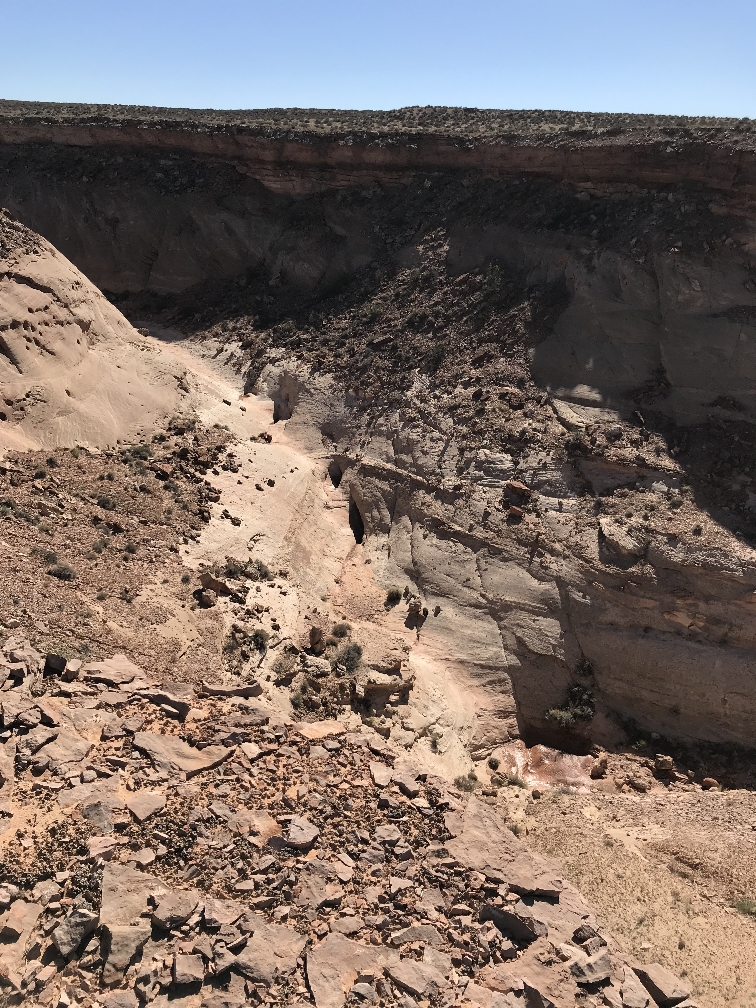
Courtesy and Copyright Shannon Rhodes, photographer
 Muddy Creek
Muddy Creek
Courtesy and Copyright Shannon Rhodes, photographer
 North Fork Pleasant Creek Terracing
North Fork Pleasant Creek Terracing
Courtesy and Copyright Shannon Rhodes, photographer
 Blackburn Draw
Blackburn Draw
Courtesy and Copyright Shannon Rhodes, photographerBrendan Wenzel says the inspiration for his picture book “A Stone Sat Still” was a familiar boulder nestled in a tidal inlet near his family’s home. This stone was a dining place, a perch, a tool, and a landmark, but dependably there day after day, year after year. When I shared this book as a writing workshop launch with fellow educators, it drew recollections of sandboxes, rock collections, garden pavers, mantle stones, stacked-stone cairns keeping us on the right trail, and deeper connections to fathers. I wrote about how stones definitely don’t sit still when I am around. When my father would take us fishing, my brothers and I would most likely be skipping every flat rock we could find across the lake’s surface instead of manning our poles. Even now I can’t resist rolling a moqui marble down desert slickrock or plucking up a river rock to chase scurrying stonefly larva beneath.
Dr. Eric Newell, director of experiential learning at Edith Bowen Laboratory School and summertime river rafting guide, wrote about the secrets stones hold for him: “I like to pick up rounded river rocks, turn them gently in my fingertips, feel the smooth contours, and wonder where they journeyed from to this resting place—how long did it take for the eons to shape and polish them? And what would rivers be without stones?—the meticulous ways the currents stack and sort boulders to sand grains by size, coming to understand that every wave on the surface of the river is created by stones beneath—and the metaphor that provides for seeing and understanding children, adults, and even myself.”
Mountains, boulders, stones, cobbles, gravels, pebbles, sand grains, silt, mud. If the water is muddy or the wind is dusty, we know erosion is happening. It forms valleys, smooths jagged rocks, and carves unexpected slot canyons in the desert. It also causes black blizzards and landslides. According to Mark Milligan of the Utah Geologic Survey, the early decades of the 1900s saw the Civilian Conservation Corps setting to work not only building canals and roads, but contour terracing to stall mountainside erosion here in Utah. There is a sign on Skyline Drive in the Manti-LaSal National Forest that reminds us that those CCC boys were digging horizontal trenches above our cities well into the 1950s.
Many people equate erosion with the destructive forces that wear down earth. Yet, in her book titled “Erosion,” Terry Tempest Williams pairs eroding with evolving. She wrote, “Water freezes and shatters stone; rocks fall from the force of gravity; new rapids appear in rivers. Storms gather and floods roar through dry washes, cutting and scouring a wider channel…” We have water, ice, wind, and time to thank for the erosion that created Natural Bridges and Arches, Coral Pink Sand Dunes and Goblin Valley, and Muddy Creek and Blackburn Draw.
I’m Shannon Rhodes, and I’m wild about erosion’s role in shaping Utah.
Credits:
Images: Courtesy & Copyright © Shannon Rhodes, Photographer
Audio: Courtesy & © Friend Weller, https://upr.org/
Text: Shannon Rhodes, Edith Bowen Laboratory School, Utah State University https://edithbowen.usu.edu/
Additional Reading Links: Courtesy Shannon Rhodes
Additional Reading:
Atwood, Genevieve. Geology of Utah. https://www.uen.org/utah_history_encyclopedia/g/GEOLOGY.shtml
Manti-LaSal National Forest Visitor Guide. https://www.fs.usda.gov/Internet/FSE_DOCUMENTS/stelprdb5370798.pdf
Milligan, Mark. What Are Those Lines on the Mountain? From Bread Lines to Erosion-Control Lines. Utah Geologic Survey Notes, v. 42 no. 1, January 2010. https://geology.utah.gov/map-pub/survey-notes/glad-you-asked/erosion-control-lines-on-the-mountains/
Olsen, Beth. Utah’s CCCs: The Conservators’ Medium for Young Men, Nature, Economy, and Freedom. Utah Historical Quarterly, Volume 62, Number 3, 1994 by Utah State History. https://issuu.com/utah10/docs/uhq_volume62_1994_number3/s/163708
Oskin, Becky. Mars on Earth: How Utah’s Fantastical Moqui Marbles Formed. 2014. https://www.livescience.com/47936-how-moqui-marbles-form.html
Wenzel, Brendan. A Stone Sat Still. 2019. San Francisco, CA: Chronicle Books. https://www.youtube.com/watch?v=P11LB4A-pjI
Williams, Terry Tempest. Erosion: Essays of Undoing. 2019. New York, NY: Sarah Crichton Books. https://www.amazon.com/Erosion-Undoing-Terry-Tempest-Williams/dp/0374280061
